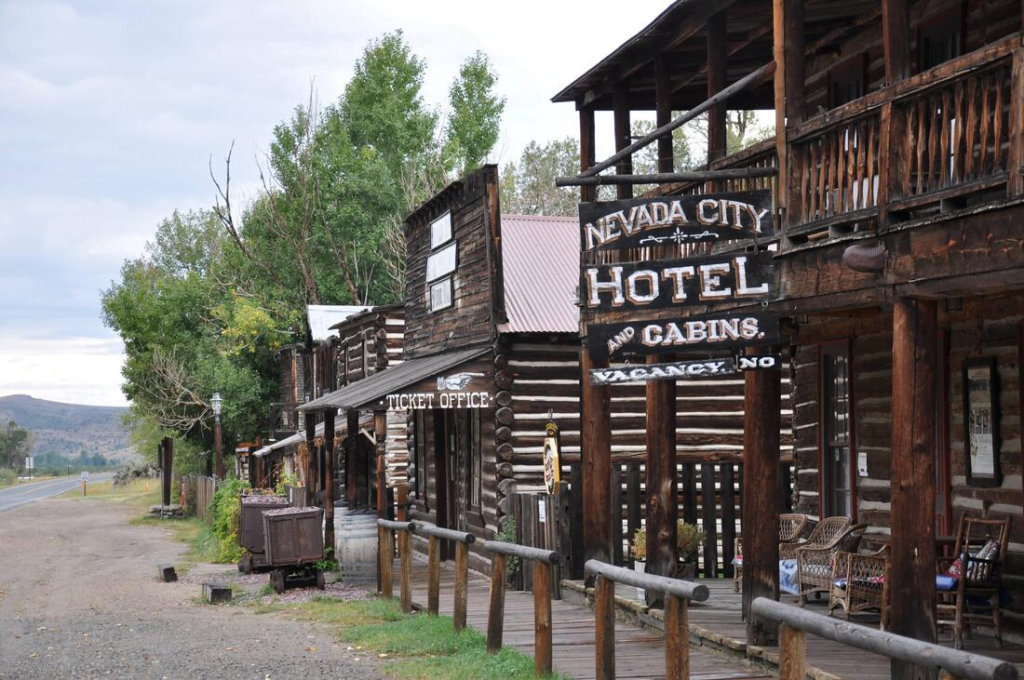
A nearly pristine example of mining camps in Montana during the gold rush, this living ghost town is settled into the mountains, with a railroad track connecting it to another ghost town a few miles away. Virginia City isn’t just a lovely place to visit for wild west history, it’s also filled with the ghosts of previous occupants, still stuck in the gold rush days. The entire city is considered haunted, with every building having their own haunting stories and unexplained events. Both ghost towns live up to their name to this day, so let’s explore Virginia City and Nevada City, Montana, today on Ghost to Coast.

Virginia City began as a mining camp shortly after gold was discovered in the Montana rocky mountains, causing a surge of people moving to the region. In 1863, gold was discovered nearby and, though the finders attempted to keep it a secret as they traveled to the nearby Bannack, but gold hungry prospectors noticed the bags filled with precious gold and about 200 people followed them back into the mountains to find their own stake. Tents and temporary structures went up in what would one day become Virginia City, and it wasn’t long before permanent structures began to be erected and a town was formed.
The name of the city was controversial, as the civil war raged on in the east, settlers in that gulch of Montana attempted to name the town “Varina,” which was the name of the wife of confederate president, Jefferson Davis. The name was rejected as they tried to register the town and the union-supporting officials changed Varina to Virginia.

Within a year, the fledgling town had a population of over 10,000, the dirt streets constant with foot traffic as people made their homes in the mountainous valley, branching out to create another town a few miles away known as Nevada City. Both towns connected by a railroad for ease of bringing supplies deeper into the mountain while mining the gold from the surrounding cliffs and hills. Virginia city grew quickly and was soon the site of the first public school in the Montana territory, as well as the first telegraph and first newspaper. The town flourished and became known as one of the richest cities in the territory, with over 30 million dollars of gold extracted from the nearby hills in just the first 3 years since the discovery in 1863.
The town began to decline quickly after, with another strike of gold in Last Change Gulch near modern day Helena. Miners quickly moved on to the next hot tip, still making their fortune in the rough terrain with pick axes and panning for gold in the river. The town began to decline in the late 19th century as Helena was named the state capitol and other strikes pulled the population out of the gulch and to the next adventure. The town held on until a quick resurgence in the 1930s as the price of gold skyrocketed. Eventually, though, the once bustling city was a ghost town, with a minimal population and damage from nearby dredging operations, which would all but destroy the nearby Nevada City.

Today, Virginia City is one of the most well-preserved cities in the west. It’s known now as a “living ghost town,” because although it has many of the original buildings, people live year round in the town and in the summer, they act as guides for the tourists hoping to experience a little bit of the wild west. Half of the city and all of Nevada City are technically owned by the state of Montana, after the legislature purchased it to protect the historical value of the region. Now, you can take tours, check out museums, and get authentic sarsaparilla at the local general store. Several hotels still stand in both Nevada and Virginia Cities. In fact, if you stay in one of the hotels, you’re advised that it’s likely you might run into a ghost in this ghost town.
Ghost hunters visiting the town say they get evidence of haunting every single time they visit the ghost town to search for ghosts. Full body apparitions have been seen in the hanging house near the cemetery, in the old opera house, and all of the lodging accommodations in the tourist attraction buildings. Fairweather Inn is considered one of the most haunted buildings in the town. People spot confederate soldiers around the walking paths of the town, harkening back to its first life as Varina.

The most famous of the ghosts of the town is the tragic tale of a 6-year old girl who passed in 1911, still wandering the streets, presumably looking for her mother. She can be seen the most on Idaho street in Virginia City. Another is the spirit of Mary Elling, who becomes troublesome when any changes are made to the mansion she built in the early days of the town. Still hanging around, she’s said to move construction tools, open doors, and turn lights on and off to express her displeasure to any workers changing her home.
One of the most haunted buildings is said to be the Bonanza Inn, originally the local courthouse. Eventually it was renovated into St. Mary’s Mining Hospital, where it witnessed many deaths from cholera, typhoid, gunshot wounds and mining accidents. A woman’s spirit is still said to care for those sleeping in the hotel, as if they were sick patients and she was sitting on their bed to soothe them. Many have awoken in the middle of the night to see a ghostly figure sitting at the end of their bed. It’s said that the activity is the worst in Room #1, which stayed closed up for decades after a night where the room’s ghostly occupants terrorized the guest staying there during a movie shoot. Knocks followed the man on the walls, doors, and windows until he gave up and slept in his car.

As one of the most haunted towns in America, as their page boasts, the town wouldn’t be complete without an October ghost tour, and this year is no exception. If you take a vacation to the town during October, you can be treated to real, local stories around the town from residents and ghost tour guides.
- About the Author
- Latest Posts

Born in Death Valley and raised on the prairie, Deborah is a Wyoming-based paranormal researcher and University of Wyoming graduate. Her interests lie in folklore, history, symbolic interaction and research. She also researches the paranormal academically and is a graduate student studying sociology.


